



Twisting Fistfuls of Time with David Rokeby
An Interview with David Rokeby, in conjunction with his first UK retrospective Silicon Remembers Carbon, FACT, Liverpool, (20th April – 10th June), by Charlotte Frost.
2nd part of the interview.
CF: That makes me want to ask whether ‘interactive’ is the right word? I was thinking about how it became a promotional buzz-word, and although undoubtedly you are a pioneer in works which developed unprecedented levels of interactivity, are there other terms that you think – perhaps today at least – better apply? For example I was thinking of proposing ‘integration art’, by way of highlighting the slippage between human and artificial intelligence in your work. Is interactivity still a term that you think works? Or is it even important to have a label for it?
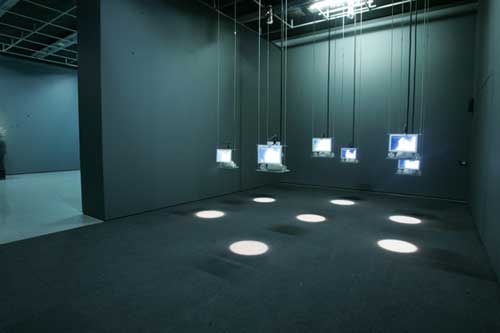
n-cha(n)t
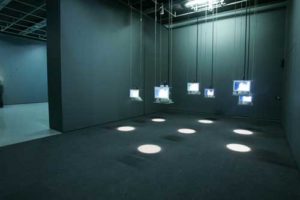
DR: I’ve never found a comfortable label for what I do. I have a very complicated relationship with language which is why I spent so much time doing [url:http://www.rokebyshow.org.uk/names.html]The Giver of Names[/url] and [url:http://www.rokebyshow.org.uk/nChant.html]n-cha(n)t[/url], which were so involved with language. I think my role is usually more to dodge descriptors as much as possible and to survive in a world between descriptors; my job is always to slip between the cracks. If someone tries to define something that’s dear to me too closely then I will probably come up with what I think is something that both fits and doesn’t fit and messes with the existence of the category.
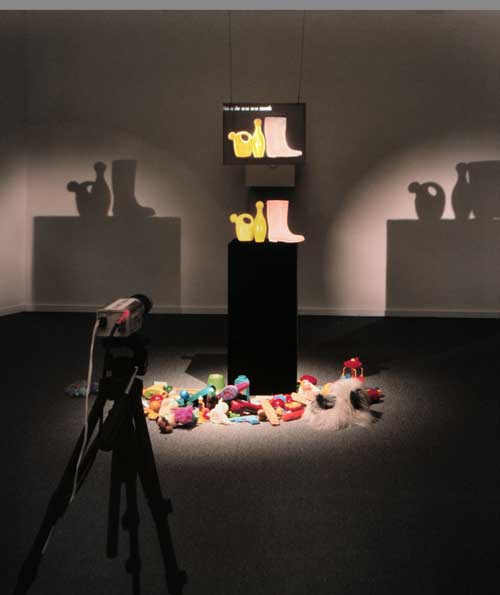
The giver of Names
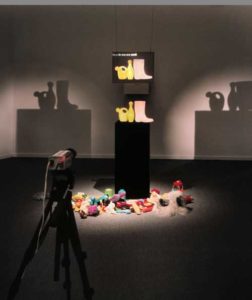
“Interactive” is useful, it certainly doesn’t apply to all my work, some of my work is very explicitly non-interactive. Some of it that could be interactive is intentionally not because there are times when interaction is not the correct mode of reception, it engages a different part of the viewer, it puts them in a different space and that’s not always the appropriate space for the work. As you noted in the previous question I have sometimes hidden interaction in works because interactivity is sometimes very useful to set-up the relationship with the artwork and the audience and if they don’t know about it then they don’t become self-conscious about it, they don’t spend time thinking about it, and it just does its thing and makes sure the audience has as close an experience with it as possible.
“Integration art” is fine except it only works if you already understand the technology framework, or rather understand that there is a technology framework around the work because integration has a lot of different meanings in a lot of different contexts. In fact one half of the work [url:http://www.rokebyshow.org.uk/watch.html]Watch[/url] is specifically integration art because it uses integration as a mathematical function to compute the image, so there are lots of different layers to that. The term ‘integrated’ is interesting because the new media section of the Canada Council for the Arts in the 1980s was called the “integrated media department”, and it was interesting because in those days new media was such a sprawling thing – sparse and sprawling – and the department ended up receiving the applications which didn’t fit anywhere else.
CF: To pick up on something you were saying on how people interact with the works, I’m wondering about the gallery space and – I know you’ve talked about your works being intimate – how intimate you think an interactive work can be in a gallery? And to what extent the artificial set-up of a gallery codes people’s behaviour, in much the same way as a computer does. It makes me think of the gallery as a Graphic User Interface for art information, can you comment on that?
DR: I like galleries, I’ve also done a fair amount of work in unmarked public space, but I like galleries for works that are designed for galleries. There is a certain space that you have in a gallery that you have almost nowhere else in our culture, which is nice. There is a kind of focus that is possible in a gallery that isn’t very common in our culture. There is a kind of mental shift that happens when you go into a gallery space – it can shut you down, you can feel threatened by it – but I tend to feel like I’m breathing a little more oxygen in the air and that I can pay a different kind of attention. I appreciate that frame around a fair number of my works. On the other hand there also tends to be a fairly small flow of people through galleries most of the time, which means it is possible often to have a fairly intimate experience.
There are times when I’ve wondered about the home as the correct environment for my pieces, the big advantage about the home is not about space but about time. What I like about the idea of pieces in the home is that the work can be experienced over long periods of time and that some of the layers I’ve put in to keep myself amused that most gallery goers don’t get in their five-to-ten-minutes of interaction with the work would have a chance to express themselves. That is in fact why I also like positioning works in public spaces over long periods of time where they can work on you over and over and you can hopefully discover new things as time goes by. I have fantasies about works in shopping malls or office foyer spaces where people go through daily and one day they are the only person leaving late from work and suddenly they get what has been going on the whole time.
I’m very jealous of novelists because they have this big chunk of time with the reader and that is the frustration for me with the gallery space, the time.
CF: That leads into a question about the learning process for audiences with your work. Looking at footage of your work on line, you often perform the works yourself and I’m wondering to what extent you are producing instruments that can be learnt and played and whether or not you think you might misrepresent the work in any way by presenting its potential – I was thinking particularly about [url:http://www.rokebyshow.org.uk/VNSystem.html]Very Nervous System[/url] or [url:http://www.rokebyshow.org.uk/taken.html]Taken[/url].
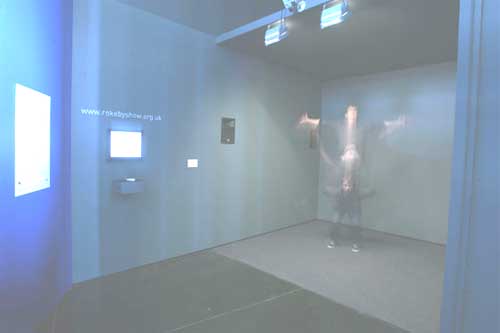
The Very Nervous System
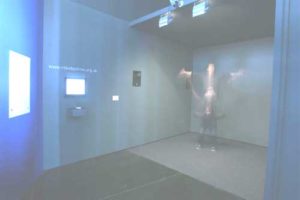
DR: The works are all intended to be accessible to someone who knows nothing about what’s going on. That being said, with Very Nervous System for example, if someone has spent more time with it there are certain kinds of languages and movement that will they have discovered that they will be able to exploit. I went through a big struggle with Very Nervous System through the 1980s with the whole question of performing in it because I was always being told “David, you are the master, you should perform in it”. The big problem with that was that it was very difficult for me to get away from what was more like a product demo than an exploration. My favourite experiences of Very Nervous System though that time were almost invariably between Very Nervous System and amateur dancers – not professional dancers because they need choreographers, and not choreographers who have too much of an idea of what they want the relationships to be – but amateur dancers who have a very comfortable way of moving and that had no agenda, with no experience of the piece, were often the most effective, the most striking – much more so than myself. I did learn over the course of that time, slowly, to be able to explore the piece and get away from the ‘product demo’ state of mind.
In terms of demo footage and what is on the web, there is the problem that you have of the task of representing something that can’t be represented, which is an interaction, which is really something that occurs in the space between the user and the system. It is something that courses through them – through the circuits of the computer and through the body and neural system of the human – but is not visible in what is actually taking place. A person could be standing still but be hyper-aware of the fact that any movement they did make would make sounds. The documentation for example of Very Nervous System that you are talking about I don’t think misrepresents the piece because it represents where many people could take it very easily. What it does do however, which drives me slowly crazy as I show clips, is that I have the actual tune memorised through over exposure, so for something whose whole purpose is to not repeat and to reinvent itself in different contexts all the time has become this ditty that is etched into my head, which is problematic or, rather, irritating! It is always a challenge to document these things and even photographs are difficult – photos of projections are always too blue – so it is a challenge to represent what you feel the experience is.
CF: I was think about Derrida and Archive Fever and how he was discussing Freud’s notion of memory being an originary writing prostheses, and Mark Hansen criticises this theory saying that it erases technology as it is internalised, and I wondered if you could comment on that notion, perhaps particularly in light of The Giver of Names and explain whether you see technology as internal or external, or both?
DR: I think there are many ways that you could define internal and external and as you choose a definition, parts of the technology would flip in and out. What interests me about that question and about “insideness” and “outsideness” is the impact of one’s awareness or lack of awareness of the presence of that technology. In engaging in any feedback scenario, working on the computer with a mouse or whatever, you are engaged in a feedback loop that reflects something back to you about yourself in a very simple manner. If you are using an interface that seems to be transparent then any experiences, any shifts or transformations that may happen in the interface have to go somewhere, they are either internalised, mapped onto yourself, or they are externalised and mapped onto the outside. Quite often they are mapped internally and I think that can be a problem because you start to carry the distortions of the interface as part of your self-definition and I think its always important to be able to critique the interfaces and it becomes more and more difficult as they approach transparency. The problem with what happens as they approach transparency is a sort of convergence process, there would be nothing transparent at all about the Macintosh user interface to Papua New Guinea native of a hundred years ago. There are sets are cultural framings around any interface which make it appear transparent because it shares assumptions that you share and in the constant exchange with technology, we develop a shared frame of reference and that just continues to build and build and build. In that case I am concerned that there are aspects of technology that we will take internally even though they are not internal, that they will be distorting in a way that is not appropriate. This is quite separate from the notion of cyborgs, in the classical sense, because this is about what you consider to be yourself, not really what is. Obviously, that is leaving aside the whole question of language and technology, and although I think that writing and memory are valid lines of inquiry, that is not so much what interests me.
I had this experience when I was first developing Very Nervous System where I spent about two months really doing nothing but working with a computer, not seeing anybody and the degree to which my expectations and what the machine was capable of doing converged over the course of those two months was astonishing. It meant that the piece was complete garbage because it wouldn’t work for anyone else because I completely transformed the way I was moving in order to work with the system, but I was not aware of it at all. To me it was completely transparent, it was astonishing, and I was going to be a star instantly. And then I took it and put it out there and it didn’t even make a sound for most people. It wasn’t until I saw myself moving on video that I realised I had drawn myself into moving like this (makes odd jerky move) and not noticing that that was unnatural at all. And that is what I mean, it is possible in that tight interaction to lose sight of what you are taking into yourself to make something transparent.
Likewise, in a piece from which this show got its name, Silicon Remembers Carbon, that was up at the Lowry Centre at Manchester for a few years, I play with shadows that appear to be yours, or not. When you feel a shadow – in this case it was a projection on the floor that was approximately appropriate to your position – you would identify with it. If the shadow moved a little bit to the right, you would move to the right to keep that transparency, you would do that without realising it, you would unconsciously sustain that as long as it didn’t do something radical. Then it would walk off, which was terrifying, because you had associated with it so much. So I guess that’s a way of illustrating what’s at the core of this issue, that we do actually take what’s not working and put it inside ourselves and try to make up for it and its dysfunctional. I don’t think we should agree to go down a dysfunctional path, we have to continue to be able to critique the stuff that wants to get inside us, so that we keep what’s inside us the way we want it to be.
CF: Well, you already answered my closing question earlier on, however, given that retrospectives are about looking back, I think we should close with what’s coming up?
DR: I just finished a 42ftx42ftx16ft kinetic sculpture that has no relationship to anything else I’ve ever done. I have a lot of shows this year, one that just opened in Spain last week, one opens in Peru next week, this one here at FACT, then a small retrospective within a larger show in Montreal next fall, for which I’m preparing a new commission. And I’m doing a bunch of works for public spaces over the summer as well: 3 pieces for an airport, and one piece for a large 50ftx30ft video screen in a main intersection in Toronto. So its kind of a mixed bag of stuff.
I’m also dredging a couple of lost pieces. I was in Berlin in February, and I have a three year old daughter and I haven’t had time to think for three years, and being in Berlin for a week without much to do got me thinking about the past few years and there are a couple of pieces that got lost in the shuffle, so I’m also resurrecting one of those right now, which is very interactive.
I’m also dealing with this big Power PC to Intel transition on the Macintoshes because so much of my code is written to take advantage of certain features of the old Macintoshes that I have this huge headache of translation which I am deeply involved with right now.
[url:http://www.furtherfield.org/displayreview.php?review_id=273]Part 1 of this interview [/url]